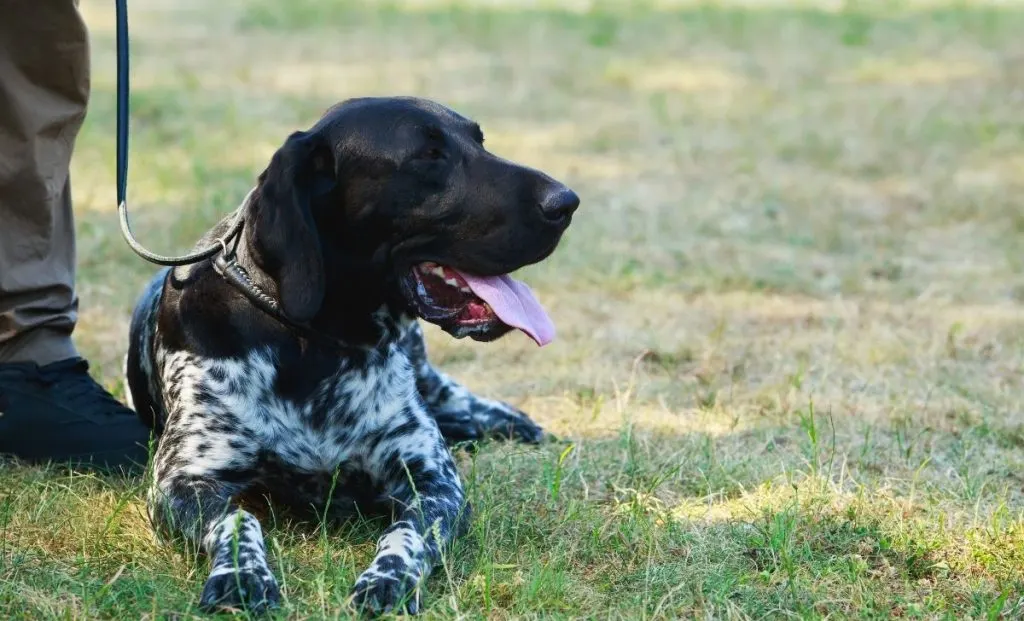When it comes to choosing between a male vs female German Shorthaired Pointer (GSP), there’s more to consider than just personal preference.
Both genders are known for being exceptional hunting dogs. They are high-energy, intelligent, and require much exercise to stay happy and healthy.
Now, if you’re a seasoned hunter or a fitness fiend, understanding the traits of male and female GSPs can help you make a good choice for your next canine companion.
So, both Shorthaired Pointers can have distinct differences that might make one a better fit for your lifestyle.
Which one to choose?
Male Vs Female German Shorthaired Pointer Key Differences
Both male and female GSPs are part of a particular breed that thrives on activity and mental stimulation. They are versatile dogs that excel in field trials and hunting, thanks to their English and Spanish Pointer lineage.
However, their temperaments and behaviors can differ in subtle yet significant ways. The following chart brings a rough overview of the major male vs female German Shorthaired Pointer differences.
| Category | Male GSP | Male GSP |
|---|---|---|
| Size | Larger | Smaller |
| Temperament | More dominant, territorial | More independent, high-strung |
| Training | Needs effort to manage dominance | Easier, but may be anxious |
| Activity Levels | Very high | Very high |
| Hunting Drive | Strong, long distances | Strong, slightly less intense |
| Crate Size | Larger crate needed | Smaller crate sufficient |
| Socialization | Needs consistent socialization | Adapts quicker to new situations |
| Maturity Rate | Slower | Faster |
| Independence | Less independent | More independent |
| Energy Levels | Consistently high | High, with occasional dips |
You see, male GSPs are often larger and may exhibit a more dominant personality, which can sometimes lead to dominance problems if not properly trained.
On the other hand, female GSPs are generally more independent and can be a bit more high-strung, but they are equally devoted and hardworking pups!
Well, let’s get into all the good info and details in the following headings!
Appearance Differences

Let’s start with the most obvious trait – the GSP looks.
These dogs have been described as having a “clean-cut, well-balanced” appearance, with a strong nose and a short, dense coat (1).
Now, there are no big differences when it comes to male vs female German Shorthaired Pointer appearance.
However, there are subtle ones and once you get to know them, you can easily distinguish between male and females.
Size
The AKC describes German Shorthaired Pointers as versatile and well-balanced hunting dogs.
Males generally have a larger, more robust build with a broader chest and head, while females are typically smaller with finer features.
It is safe to say that growing GSP puppies are among the cutest creatures ever. You may not see size differences between young littermates, but once they grow into adults, it becomes quite obvious.
Male GSPs are generally larger, standing about 23-25 inches tall and weighing between 55-70 pounds.
On the other hand, female GSPs tend to be slightly smaller, with heights ranging from 21-23 inches and weights between 45-60 pounds.
Here’s a better preview:
| Gender | Height (inches) | Weight (lbs) |
|---|---|---|
| Male | 23 – 25 | 55 – 70 |
| Female | 21 – 23 | 45 – 60 |
As you see, these dogs are not among giant breeds, but they are also not as small as Beagles, for example.
This size variation is quite obvious because it not only influences the type of dog you might prefer but also impacts how they might perform in field trials and hunting scenarios, given that their physical stature affects their endurance over long distances and activity levels.
Coat Colors
When it comes to the coat colors of German Shorthaired Pointers (GSPs), an interesting fact is that there is no variation between males and females.
Both GSP genders can sport the same array of colors.
This equality in coat colors means that whether you choose a male or female GSP, your decision won’t be influenced by color preferences but rather by other attributes that may align more closely with your lifestyle.
Contrary to some beliefs, the coat color of a GSP is established early and doesn’t change as they age. Their unique spottings and ticking provide a beautiful and consistent appearance for their entire life.
When planning a breeding pair, color might be considered for aesthetic or competition purposes, but it’s the individual dogs’ health and temperament that are paramount.
Differences In Temperament

We talk about differences in temperament in many of the incredible dog breeds here at Breed Atlas. Why? Because all dogs have different personalities, of course! That includes male vs female German Shorthaired Pointers too.
Okay so, diff breeds have diff personalities, but what makes the GSP boys and girls so different?
What Is A Male GSP Temperament?
Male German Shorthaired Pointers exhibit a lively and gentle temperament. Some people may say that most of the time males tend to be more stubborn than female GSPs, but that can’t be further from the truth.
They tend to be very enthusiastic about their exercise, always ready to switch into hunt mode with considerable stamina and vigor.
With that in mind, a male GSP requires a secure area where he can expend energy safely. It is also important to ensure that he has a safe haven at home where they feel secure. Now, this is not just a good thing, but it’s a must for keeping him healthy and happy.
They have a strong desire for interaction and can often seek constant attention from their family members.
Due to their size and energy levels, male GSPs can sometimes be a lot of puppy to handle, especially in their younger years when they’re still learning the ropes.
They are naturally playful and gentle with children, though their robust enthusiasm (plus their big size) might be overwhelming for smaller kids.
This is why good puppy advice from a reputable breeder or a started dog program can be very helpful. These professionals often provide the early training that helps male GSPs become well-adjusted, good obedient dogs.
Raising a male GSP is certainly hard work and involves more than just providing a balanced diet and exercise.
What Is A Female GSP Temperament?
Moving on to the lady GSPs! Well, these girls are a little bit different than the boys.
Much like their male counterparts, female GSPs are driven by a passion for running and hunting, always ready to switch into hunt mode. However, they might be a bit more laid-back than the playful males.
What’s interesting is that some breeders and dog enthusiasts claim that female GSPs might be more hard-headed than males. I think this all comes down to different breeding practices and perhaps the age difference between the dogs.
While they can be high strung, this trait is usually manifested in their happy-go-lucky approach to life. They are as cheerful and eager to learn, as are other medium to large breeds, like the Belgian Malinois.
Their response to strangers is generally warm but measured, neither too distant nor overly friendly, maintaining a balanced temperament that’s welcoming yet reserved.
When it comes to other dogs, females usually coexist peacefully, though their natural prey drive suggests caution around other pets.
For those lucky enough to share their home with a female GSP, she will not only be a source of joy but also proof that good things come with a dedicated companionship.
Trainability

Now that we know a bit about the male vs female German Shorthaired Pointer temperament, it is time to say a few words about their trainability. If you’ve guessed that these dogs are easy to train, well, you may have guessed right.
Both genders are incredibly smart and able to learn tricks and commands at a very fast pace. But, both genders tend to be a bit stubborn from time to time, which can make it difficult to train them.
What also plays a role in their stubborn streak is the fact that they were bred as hunting dogs. This has instilled in them a strong, instinctual focus on tracking and pointing out prey.
In fact, their hunting instincts are often stronger than in Labradors for example, who while also bred for hunting, typically exhibit a gentler approach.
They often show their distinctive stance known as “pointing,” where the dog freezes, nose directed towards the scent, often with one paw lifted, silently marking the prey’s position without startling it.
This intense concentration and singular focus, bred into them for generations to enhance their effectiveness in field trials, can manifest as stubbornness during non-hunting activities.
They might appear overly fixated or unresponsive to commands unrelated to tracking or pointing.
This is what both male and female GSPs have in common. But, which one is easier to train?
Male German Shorthaired Pointer Trainability
Male GSPs are responsive to engaging and positive training methods. They are intelligent and pick up on both commands and cues quickly, but they do not respond well to harsh words or negative reinforcement.
Instead, these adorable boys thrive under positive reinforcement techniques such as treats, praises, and play. Of course, such an approach can motivate them to learn and adhere to commands more effectively.
As with all dog breeds, starting training early is very important! GSP puppies as young as eight weeks old can begin learning basic commands and socialization, which sets the foundation for more advanced training later.
Neutering can help with managing some undesired behaviors in male GSPs, especially those linked to dominance or territorial aggression (2).
It can also reduce tendencies such as roaming and certain types of aggression, making them more amenable to training and generally easier to manage (3).
Female German Shorthaired Pointer Trainability
When it comes to training environments, female GSPs are like attentive students.
They thrive on positive feedback and are quite sensitive to the emotional tone of their trainers.
A harsh word might set them back, making them somewhat hesitant, while encouragement and praise can propel them forward, eager to please and learn more!
Their focused and calm demeanor during training means they can often stay on task longer and with fewer distractions compared to their male counterparts, who might occasionally turn a training session into playtime.
An interesting research suggests that while their male counterparts may sometimes display higher levels of aggression and a touch of immaturity, female dogs tend to shine in obedience and ease of training (4).
This may also be linked to how female GSPs excel in tasks such as housebreaking and following basic commands.
While the generalizations about the trainability and temperament of male and female German Shorthaired Pointers can provide helpful guidelines, it’s important to remember that individual dogs can vary significantly.
There is no absolute rule that all female GSPs are easier to train or that all males exhibit more aggression or immaturity.
Are Male Or Female GSP Better For Hunting?

This is one of those tough questions that is a bit difficult to answer. In fact, there is no right or wrong answer to it.
It really comes down to individual preference and the specific dog’s traits rather than their gender. Both male and female GSPs are excellent hunters, athletes, and incredibly smart dogs.
What matters most is the individual dog’s training, temperament, and how well they bond with their owner.
Male GSPs are often seen as having a bit more raw power and stamina, which can be advantageous during long hunts. Females, on the other hand, are known for their focus and precision. They might be a bit more methodical in their hunting style.
A study has shown that GSPs have a relatively low level of inbreeding and good genetic variability. This genetic diversity helps maintain the health and vigor of the breed, making both male and female GSPs robust and effective hunting companions and athletes (5).
So, instead of focusing on whether a male or female GSP is better for hunting, consider the individual dog’s personality and how well they fit with your hunting style and training methods.
Health
Luckily, German Shorthaired Pointers (GSPs) are generally robust and healthy dogs, thanks to their pawesome genetics.
However, like all breeds, GSPs can be prone to certain health issues.
Both male and female GSPs may be prone to common breed-related health conditions, such as:
- Hip dysplasia
- Bloat
- Dysautonomia
- Neuronal Ceroid Lipofuscinosis (NCL)
So, whether you have a male or a female, it is wise to be up to date with regular veterinary care. Now, let’s see what kind of health issues may arise in different genders.
Male German Shorthaired Pointer Health
Male GSPs, with their larger size, might be more prone to orthopedic issues, such as elbow dysplasia and hip dysplasia.
Neutering males can help prevent certain health issues like testicular cancer and can also reduce the risk of some behavioral problems.
Having said that, it’s important to monitor their weight and activity levels to keep their joints healthy and prevent obesity.
Female German Shorthaired Pointer Health
Female German Shorthaired Pointers are generally healthy, but they are prone to specific health issues that owners should keep an eye on.
One of the most common concerns is the risk of mammary tumors, particularly in unspayed females. This type of cancer can be quite serious, making early detection and treatment crucial.
Another significant health concern is pyometra. This condition typically occurs in older, unspayed females and requires immediate veterinary attention.
Spaying your GSP can significantly reduce these risks and contribute to a longer, healthier life (6).
In addition to these gender-specific issues, female GSPs, like their male counterparts, can also suffer from hip dysplasia and bloat.
Regular veterinary check-ups are a must!
Lifespan
When it comes to male vs female German Shorthaired Pointers, both are known for their vitality and generally robust health!
In return, this contributes to a healthy lifespan for the breed.
On average, GSPs live between 12 to 14 years, with some individuals even surpassing this range with good care and a healthy lifestyle.
Is It Better To Get A Male Or Female German Shorthaired Pointer?
It is time for the final verdict – which one is the best male vs female German Shorthaired Pointer? Which one should I get?
Well, consider getting both!
If you’re looking for a playful and sometimes more boisterous friend, a male GSP might steal your heart.
They tend to be a bit more energetic and enthusiastic, making them great for active families who love outdoor adventures.
On the other hand, female GSPs are often a bit more focused and can be slightly easier to train. They are wonderful companions for those who appreciate a mix of affection and a bit of self-reliance in their dog.
In all honesty though, the best choice is the one that fits your lifestyle and connects with your heart! Good luck, I am sure that you will be a pawesome pet parent for your new GPS pup!
References
1. McCarthy, D., & Mccarty, D. (1980). German Shorthaired Pointer. Definitions. https://doi.org/10.32388/kubbz5.
2. Kolkmeyer, C. (2021). Behavioural Correlates of Neutering Male Dogs -a Question of Breed?. Journal of Veterinary Science & Medicine. https://doi.org/10.13188/2325-4645.1000054.
3. Hopkins, S., Schubert, T., & Hart, B. (1976). Castration of adult male dogs: effects on roaming, aggression, urine marking, and mounting.. Journal of the American Veterinary Medical Association, 168 12, 1108-10 .
4. Takeuchi, Y., & Mori, Y. (2006). A comparison of the behavioral profiles of purebred dogs in Japan to profiles of those in the United States and the United Kingdom.. The Journal of veterinary medical science, 68 8, 789-96 . https://doi.org/10.1292/JVMS.68.789.
5. Boccardo, A., Marelli, S., Pravettoni, D., Bagnato, A., Busca, G., & Strillacci, M. (2020). The German Shorthair Pointer Dog Breed (Canis lupus familiaris): Genomic Inbreeding and Variability. Animals : an Open Access Journal from MDPI, 10. https://doi.org/10.3390/ani10030498.
6. Hoffman, J., O’Neill, D., Creevy, K., & Austad, S. (2018). Do Female Dogs Age Differently Than Male Dogs?. The Journals of Gerontology: Series A, 73, 150–156. https://doi.org/10.1093/gerona/glx061.

Meet Iram, a devoted veterinarian, passionate dog lover, and current Ph.D. candidate at Utrecht University in the Netherlands. Seamlessly blending her roles as a vet and content writer, Iram channels her love for dogs into heartfelt narratives.
Since childhood, Iram nurtured a dream of becoming a vet, a passion that runs deep in her family. Having now fulfilled that dream, she’s eager to share her acquired knowledge. In her writing, Iram not only explores the emotional bond between humans and their canine friends but also integrates her veterinary expertise, offering readers a holistic understanding of their beloved pets.
